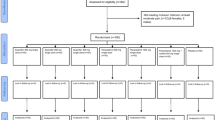Summary
The SUR 2647 combination is a sachet formulation containing free paracetamol and its N-acetyl-methionate ester (SUR 2647). In a randomized, single-blind, between-patient study the onset of analgesia, duration and efficacy of the SUR 2647 combination vs paracetamol was investigated in outpatients after oral surgery. One group (n=27) received sachets of SUR 2647 combination 2 b.i.d. (equivalent to 2 g paracetamol ×2) on the day of operation, and one sachet b.i.d. (equivalent to 1 g paracetamol ×2) for the following two days. The other group (n=26) received paracetamol tablets 2 q.i.d. on the day of operation (1 g×4) and one tablet q.i.d. (0.5 g×4) for the following two days. Several objective and subjective assessments, including pain score on a visual analogue scale, were recorded for comparison of the postoperative courses. Median onset of analgesia for both groups was ⩽0.5 h. The duration after SUR 2647 combination was ⩾5.5 h as compared to ⩾2.5 h for paracetamol. Mean pain scores showed that the SUR 2647 combination regime reduced pain significantly more than the paracetamol regime from 0.5 to 3.0 h after initiation of medication. The mean pain scores did not show a significant difference during the remaining observation period. Mild to moderate drowsiness was reported in both treatment groups, but it was more common in subjects given SUR 2647 combination.
Similar content being viewed by others
References
Amer B, Greenblatt DJ (1977) Acetaminophen. Ann Intern Med 87: 202–209
Beaver WT (1965) Mild analgesics: a review of their clinical pharmacology. Am J Med Sci 250: 577–604
Bhattacharyya GK, Johnson RA (1977) Statistical concepts and methods. Wiley, New York Toronto, pp 187–333
Calder IC, Hart SJ, Healey K, Ham KN (1981) A postulated toxic metabolite of acetaminophen. J Med Chem 24: 988–993
Crome P, Vale JA, Volans GN, Widdop B, Goulding R (1976) Oral methionine in the treatment of severe paracetamol (acetaminophen) overdose. Lancet 2: 829–830
Downie WW, Leatham PA, Rhind VM, Wright V, Branco JA, Anderson JA (1974) Studies with pain rating scales. Ann Rheum Dis 37: 378–381
Forrest JAH, Clements JA, Prescott LF (1982) Clinical pharmacokinetics of paracetamol. Clin Pharmacokinet 7: 93–107
Fournier EP (1980) Acute intoxication and illness due to mild analgesics. Br J Clin Pharmacol 10: 381S-384S
Heading RC, Nimmo J, Prescott LF, Tothill P (1973) The dependence of paracetamol absorption on the rate of gastric emptying. Br J Pharmacol 47: 415–421
Hepsø HU, Løkken P, Bjørnson J, Godal HC (1976) Double-blind crossover study of the effect of acetylsalicylic acid on bleeding and postoperative course after bilateral oral surgery. Eur J Clin Pharmacol 10: 217–225
Hopkinson JH, Smith MT, Bare WW, Levin HM, Posatko RJ (1974) Acetaminophen (500 mg) versus acetaminophen (325 mg) for the relief of pain in episiotomy patients. Curr Ther Res 16: 194–200
Jollow DJ, Mitchell JR, Potter WZ, Davis DC, Gillette JR, Brodie BB (1973) Acetaminophen-induced hepatic necrosis. II. Role of covalent binding in vivo. J Pharmacol Exp Ther 187: 195–202
Koch-Weser J (1976) Acetaminophen. N Engl J Med 295: 1297–1300
Løkken P, Skjelbred P (1980) Analgesic and anti-inflammatory effects of paracetamol evaluated by bilateral oral surgery. Br J Clin Pharmacol 10: 253S-260S
McLean AEM (1974) Prevention of paracetamol poisoning. Lancet 1: 729
McLean AEM, Day PA (1975) The effect of diet on the toxicity of paracetamol and the safety of paracetamol-methionine mixtures. Biochem Pharmacol 24: 37–42
Meredith TJ, Goulding R (1980) Paracetamol. Postgrad Med J 56: 459–473
Mitchell JR, Jollow DJ, Potter WZ, Gillette JR, Brodie BB (1973) Acetaminophen-induced hepatic necrosis. IV. Protective role of glutathione. J Pharmacol Exp Ther 187: 211–217
Prescott LF (1980) Hepatotoxicity of mild analgesics. Br J Clin Pharmacol 10: 373S-379S
Rawlins MD, Henderson DB, Hijab AR (1977) Pharmacokinetics of paracetamol (acetaminophen) after intravenous and oral administration. Eur J Clin Pharmacol 11: 283–286
Skjelbred P, Løkken P (1980) Phenazone versus placebo: Effects on postoperative course. Eur J Clin Pharmacol 18: 327–332
Yaffe SJ (1981) Comparative efficacy of aspirin and acetaminophen in reduction of fever in children. Arch Intern Med 141: 286–292
Author information
Authors and Affiliations
Rights and permissions
About this article
Cite this article
Skoglund, L.A., Skjelbred, P. Comparison of a traditional paracetamol medication and a new paracetamol/paracetamol-methionine ester combination. Eur J Clin Pharmacol 26, 573–577 (1984). https://doi.org/10.1007/BF00543487
Issue Date:
DOI: https://doi.org/10.1007/BF00543487




